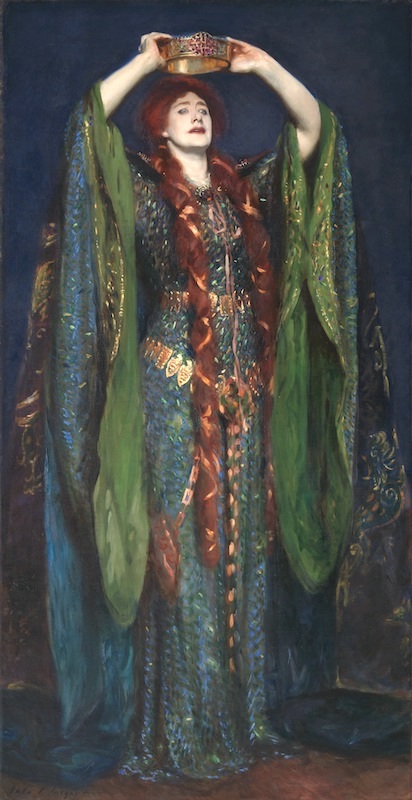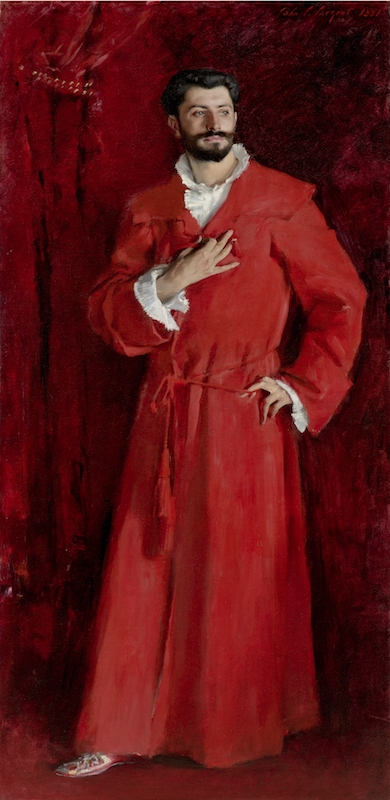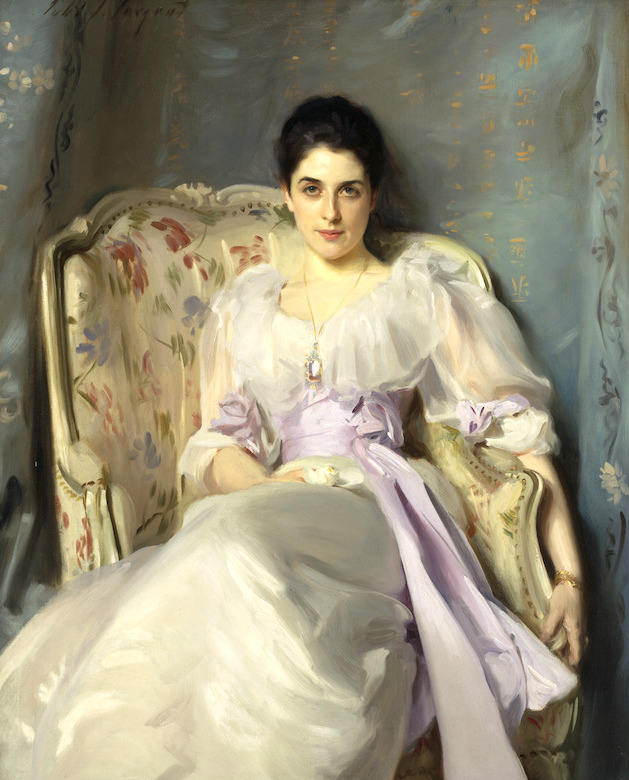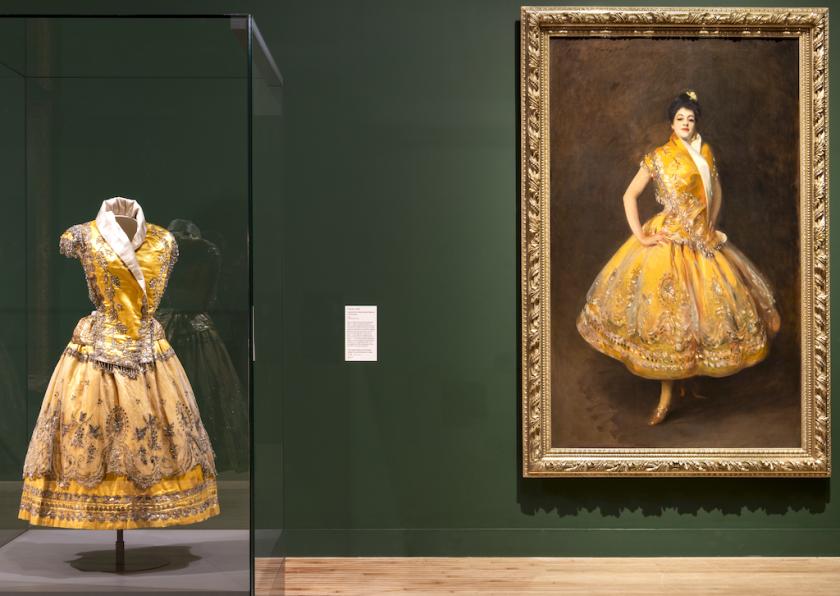At the turn of the 20th century, London’s smart set queued up to get their portraits painted by American-born artist John Singer Sargent. Sitting for him was a performance, a way to show the world just how rich, glamorous, clever or important you were. And everything – from the pose to the hair, jewellery and clothing – was stage-managed to create the best impression.
At Tate Britain, the brilliance of Sargent’s showmanship is on display from the start in his 1907 portrait of Lady Sassoon, who stands decked in an opera cape. Beside the painting is the garment itself, a gorgeous confection that envelops the wearer in a cocoon of black taffeta – not a promising start for a picture. But Sargent opens the cape to reveal the white lace blouse, pearl necklace and bracelets hidden beneath and exposes the pink lining to create a dramatic diagonal from the sitter’s bright eyes down to her expressive hands. What could have been a dull vertical is transformed into a swirl of energy and implied movement, as though Lady Sassoon were brushing past you on her way to the concert hall. No wonder Auguste Rodin dubbed Sargent “the Van Dyck of our time”.
 In his 1889 portrait of actress Ellen Terry as Lady Macbeth (pictured right) the artist chose to show her at a moment of triumph – holding a gold crown above her head in anticipation of becoming Queen of England. Also on show is the actual dress worn by Terry, a magnificent gown designed by Alice Laura Comyn Carr of dark green crochet resembling chainmail under a magenta velvet cloak embroidered with golden lions. Hundreds of jewel beetles create points of iridescent turquoise as they catch the light; but the ensemble was still too dark to show up well on canvas, so Sargent lightened the colour and offset the greenish blue with a brass belt and long ropes of auburn hair.
In his 1889 portrait of actress Ellen Terry as Lady Macbeth (pictured right) the artist chose to show her at a moment of triumph – holding a gold crown above her head in anticipation of becoming Queen of England. Also on show is the actual dress worn by Terry, a magnificent gown designed by Alice Laura Comyn Carr of dark green crochet resembling chainmail under a magenta velvet cloak embroidered with golden lions. Hundreds of jewel beetles create points of iridescent turquoise as they catch the light; but the ensemble was still too dark to show up well on canvas, so Sargent lightened the colour and offset the greenish blue with a brass belt and long ropes of auburn hair.
By contrast, the gold silk dress worn by dancer Carmen Dauset Moreno for her performance as La Carmencita (main picture) shines in the light and its bell-shaped skirt emphasises her hourglass figure, so there was no need for embellishment. Her dancer’s poise also makes for a perfect demonstration of elegance. The gynaecologist Dr Pozzi posed a much greater challenge. Instead of portraying him in a dull suit, though, Sargent painted the doctor (pictured below left) wearing a bright red dressing gown and embroidered slippers standing in front of a theatrical crimson curtain, as though he were playing a character in a murder mystery.
To add a frisson to his statuesque figure of Virginie Amélie Gautreau, whose beauty he celebrated in a striking profile, Sergeant painted the diamond strap of her black evening dress slipping down off her shoulder. When it was show at the Paris Salon in 1884, though, the picture got a chilly reception for its perceived indecency and, bowing to pressure, the artist repainted the strap in its “correct” position.
Ena was the daughter of Asher Wertheimer, a prominent art dealer and one of Sargent’s best patrons. The artist portrays her clearly having fun in an inventive set up which transforms the tedium of posing into a playful act of high drama. Sporting a hat embellished with white feathers and draped in a black satin cloak improvised from a studio prop that Sargent was using for a painting of the Duke of Marlborough, the smiling Ena happily assumes the role of a swash buckling cavalier.
 Sargent was drawn to people who broke the rules governing how men and women should present themselves. His sketch of Violet Paget, who wrote under the deliberately androgynous pseudonym of Vernon Lee, shows her wearing plain, rather masculine clothing. Dashed off in an hour, the picture conveys her lively intelligence with bright eyes seen behind rimless glasses, which the author thought made her look “rather fierce and cantankerous”.
Sargent was drawn to people who broke the rules governing how men and women should present themselves. His sketch of Violet Paget, who wrote under the deliberately androgynous pseudonym of Vernon Lee, shows her wearing plain, rather masculine clothing. Dashed off in an hour, the picture conveys her lively intelligence with bright eyes seen behind rimless glasses, which the author thought made her look “rather fierce and cantankerous”.
And his painting of Jane Evans, who ran a boarding house at Eton College, shows her in a smartly tailored black wool suit – every inch an authority figure who brooks no nonsense from unruly pupils. She was said to be able “to see through a boy as if he were a pain of glass” and her stern expression and unsmiling eyes make you believe it!
Sometimes the clothes are more interesting than the sitter and on show are a tad too many pictures of wannabes and their cloyingly sweet offspring, which feel dutifully churned out to order. Sometimes it’s hard to gauge the artist’s attitude towards his sitters. In Sargent’s portrait, Charles Stewart, Marquess of Londonderry is dwarfed by the Great Sword of State which he had carried at the coronation of King Edward VII and now holds aloft like a giant erection. To my eyes, the whole ensemble of ermine-lined, red velvet cloak, white breeches and heavily brocaded jacket looks ludicrously pompous but, who knows, it was over 100 years ago and maybe the American artist was dazzled by this ritualised display of tradition and status.
Sargent’s portrait of Lady Agnew of Lochnaw (1892) (pictured below right) suggests enormous respect for his sitter and also shows the artist at his very best. Her white silk dress and its lavender sash and organza sleeves are rapidly conjured with long, loose brushstrokes. The picture was completed in just six sittings yet that gave the painter enough time to focus on Lady Agnew’s face and capture her steady gaze with remarkable intensity. There’s a delightful contrast between her composure and the speedy gestures which activate everything around her. She is like a still, small voice of calm anchoring a flurry of activity.
 After so many portraits of well-heeled citizens mostly produced to commission, it’s a joy to see pictures that Sergeant dashed off for his own pleasure. Especially delightful is an impressionistic glimpse of a group of friends relaxing in the grass. Dot Palmer rests under a parasol while her lover Lawrence Harrison lounges nearby and his brother lies spreadeagled across his companions. The Daily Telegraph commented on their “magnificent disregard of conventional proprieties”, but what strikes me most is the vigorous flurry of brush marks with which Sargent conjures this happy scene. The feeling of gay abandon comes as much from the incredible freedom of his paint handling as from the subject matter. A true master.
After so many portraits of well-heeled citizens mostly produced to commission, it’s a joy to see pictures that Sergeant dashed off for his own pleasure. Especially delightful is an impressionistic glimpse of a group of friends relaxing in the grass. Dot Palmer rests under a parasol while her lover Lawrence Harrison lounges nearby and his brother lies spreadeagled across his companions. The Daily Telegraph commented on their “magnificent disregard of conventional proprieties”, but what strikes me most is the vigorous flurry of brush marks with which Sargent conjures this happy scene. The feeling of gay abandon comes as much from the incredible freedom of his paint handling as from the subject matter. A true master.
- Sargent and Fashion at Tate Britain until 7 July
- More visual arts reviews on theartsdesk









![SEX MONEY RACE RELIGION [2016] by Gilbert and George. Installation shot of Gilbert & George 21ST CENTURY PICTURES Hayward Gallery](/sites/default/files/styles/thumbnail_125_x_125_/public/mastimages/Gilbert%20%26%20George_%2021ST%20CENTURY%20PICTURES.%20SEX%20MONEY%20RACE%20RELIGION%20%5B2016%5D.%20Photo_%20Mark%20Blower.%20Courtesy%20of%20the%20Gilbert%20%26%20George%20and%20the%20Hayward%20Gallery._0.jpg?itok=3oW-Y84i)





Add comment